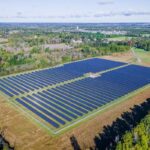Products You May Like
In 2024, the U.S. community solar sector achieved a remarkable milestone by installing 1.7 gigawatts (GW) of solar capacity, marking a significant 35% increase compared to the previous year. This growth was highlighted in a report from Wood Mackenzie, in collaboration with the Coalition for Community Solar Access. The increase in installed capacity reflects the growing adoption and support for community solar projects across the nation, driven by various factors including state policies, financial incentives, and a heightened awareness of renewable energy’s benefits.
Community solar allows multiple customers to benefit from a single solar installation, often located off-site, making it accessible for those who may not have the means or suitable conditions to install solar panels on their own properties. This model promotes inclusivity by providing opportunities for renters, low-income households, and those with shaded roofs to participate in solar energy production. As a result, community solar has become an attractive option for enhancing energy equity and expanding access to renewable energy.
The increase in capacity indicates a positive trend in the community solar market, showcasing its potential to contribute significantly to the U.S. renewable energy landscape. Various states have implemented policies that encourage the growth of community solar, providing financial incentives, streamlining permitting processes, and establishing renewable energy goals. Programs designed to support the expansion of solar energy have proven effective in driving interest and investment.
The report also emphasizes the growing importance of community solar in meeting broader climate and energy goals. As states move to reduce emissions and increase renewable energy sources, community solar can play a crucial role in helping to achieve these objectives. By providing local energy solutions and reducing reliance on fossil fuels, community solar not only helps curb greenhouse gas emissions but also fosters energy resilience and security.
Overall, the 1.7 GW installed in 2024 highlights the momentum of the community solar segment and its essential role in advancing a sustainable energy future. From enhancing energy access to supporting environmental initiatives, community solar demonstrates a viable and scalable approach to harnessing solar power for the benefit of diverse communities across the United States.
